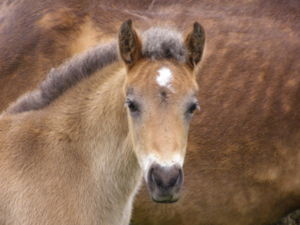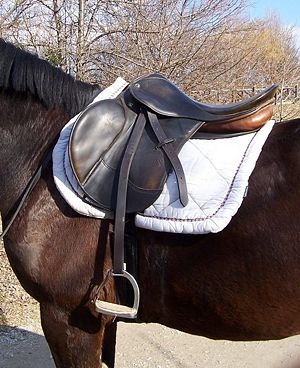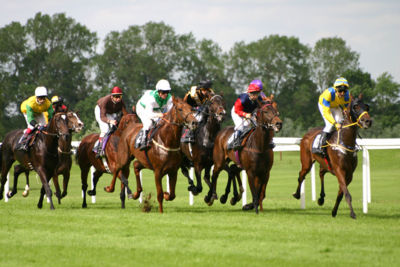Horse/Choosing a horse: Difference between revisions
imported>AnnaLisa Allegretti (→Age) |
imported>John Stephenson m (moved Choosing a horse to Horse/Choosing a horse: Not an article but an advice guide) |
(No difference)
| |
Latest revision as of 11:53, 22 August 2013
Choosing a horse is no small decision, since owning a horse is a large commitment, much larger than required for any other common domestic animal. Any new horse owner is best off tackling the task of finding that first horse with the help of real professionals, including the teachers and trainers that know her riding skills and personality. But, like with every other important decision, the final choice is up to the individual making it. Armed with knowledge, the novice horse-buyer is in a better position to navigate the process of finding, buying, and settling in the right horse. This article reviews some of the basic advice that has been published by equestrians on those topics.
Horse or pony?
Age
Horse age can be a major deciding factor in selection of a suitable mount, but is not truly indicative of potential success. Most horses will still be physically developing in dramatic fashion until the age of 6 years. Many youngsters are started under saddle when they are approximately 3 years old, but cannot endure serious physical or mental challenges at this age. One must also consider that at around 3 years old, a horse will begin to develop his permanent teeth, resulting in significant changes in dentition. At approximately 4 years of age, training can begin with slightly more demand, but always considering that the horse is still physically and mentally developing.
If one is selecting a first horse, youngsters can be a challenge and a treat. Often, they do not know enough to be afraid of things an older horse would be wary of, and may even enjoy new scenarios, when introduced in proper fashion. At the same time, they lack the wisdom an older horse has acquired and may be more reactive to unfamiliar stimuli.
In geldings, canine teeth will erupt around the age of 5 years, though mares will occasionally experience this eruption as well.
Horse age is an approximation of 2 years for every human year, with more rapid development in the early years, so that an 8 year old horse is approximately the equivalent of an 18 year old human. Age does not always correspond to maturity, but at around 12 years of age a horse is expected to be fairly set in his personality.
Many horses carry riders well into their 30s and even 40s (though this is less common), and yes a much older horse can be mellower, but age is relative, just as it is with humans.
When considering the age of a horse for selection, you must primarily consider your own experience, as youngsters require more knowledge and training; the horse's previous experience- because a 7 year old horse with no time under saddle may be harder to handle than a youngster; and your intentions for the horse. A very young horse isn't recommended for heavy work and competition, while a very old horse may only be up for the occasional hack or trail ride. The prime age for riding horses is generally between 6 and 17 years old.
But always remember, age is relative and there are very quiet youngsters and very active seniors!
Breed
Which breed of horse or pony?
Gelding, Mare, or Stallion?
Unlike dogs and cats, the female horse is rarely de-sexed (neutered) surgically. This is very major surgery in equines. Rarely, such surgery might be recommended for behavioral or health problems, but it is never routine.
Colts, on the other hand, are commonly castrated in their early years and, after this neutering, are called geldings. Stallions are the relatively few adult male horses that have been "left entire". There are certain breeds of horses, such as Lippanzers, in which the colts are regularly allowed to become stallions, but in many other breeds this is discouraged because the full-grown stallion is so difficult to control, especially around either a mare in heat (estrus) or another stallion.
The hormones produced by the stallion's testes
Discipline: what do you want from the horse?
Western or English?
Western or English refers to a style of riding that involves two completely different types of equipment or "tack". Tack is the saddle, bridle and bit (or lack thereof) - basically anything that is put on a horse for the purpose of riding or driving (more about driving later).
Western Tack encompasses the type of saddle we think of as a cowboy saddle. It was designed with work and protection of the horse and rider in mind. It is generally a heavier saddle that has a horn, higher cantle and the stirrups have fenders. The stirrups where you place your feet also have a tendency to be wider and heavier weight, sometimes covered for riding through heavy brush (tapaderos). The girth is usually cinched to the saddle via straps and dee rings and sometimes there is a seond girth also. There are several variations of a Western Saddle that make it more usable. For instance, a barrel saddle has a deeper seat and a high cantle and pommel to hold the rider is as they run around barrels. A roping saddle will have a strengthened horn so the rider can dally (or wrap) the rope around it and not have it break off. A pleasure saddle is a bit flatter and tends to have more padding in the seat for those long trail rides. Western bridles do not have a caveson or nose band. Some horses are ridden with a bosal. Generally, the reins on the bridle of a horse in Western Attire are open or separate.
English tack encompasses several types of saddles used for different disciplines. Dressage, Jumping (forward seat), pleasure and racing all have their own style of saddle specifically designed for their discipline. English saddles are designed along the principles of light weight and minimal restriction of the horse and rider. All English type saddles have a lower, rounded pommel (with no horn) a slight cantle, flaps that fall on either side of the saddle, straight stirrup leathers with lightweight metal stirrups. An English saddle is attached to the girth via buckles, either two or three and there is only only girth. A dressage saddle has a deeper seat and longer flaps to provide close contact with the horse. Jumping or forward seat saddles are designed to help keep the rider's weight centered over the balance point of the horse and to enable to rider to not hinder the horse's ability to jump. The are generally bery flat in the seat and have rounded flaps to protect the horse and rider as they move forward into a "two-point position" when jumping. A pleasure saddle appears to be a combination of the Dressage and Forward Seat saddles - meadium depth to the seat and rounded, but slightly longer. flaps than a forward seat.
The decision to ride either English or Western should depend upon the type of riding you choose to partipate in. Your horse should factor into this equation because certain breeds can be better at one discipline or the other.
Competition
Trail (Hack)
Companion horse
Horses are herd animals and it is a very rare horse who is happy living alone. Although some owners provide their horse with an animal of another species, like a goat, to provide needed company, there are many "companion horses" for sale (or for free) that can make the paddocks a happier place for a single horse. In 'horsepeople terms", a companion horse is generally not one that can or should be ridden or used for any purpose except companionship for another horse.
Available facilities: what can you offer the horse?
"Horse traders"- Caveat emptor!
Where can a horse be obtained?
Breed Organizations
Trainers
Public sales
Auctions
Rescue horses
In the UK, the RSPCA offers horse adoption [1]
Racehorses
Thoroughbred race horses [2]. Other organizations place a variety of race horses, including standard bred pacers [3]
How can a horse be properly evaluated?
Avoiding injury
The reality of equestrian activities is that death and serious injury, including permanent paralysis, are not rare events. Such outcomes cannot be entirely prevented by proper training of horse and rider, the correct use of sound equipment in adequate facilities, or by riding only under proper supervision - but they can be readily prompted by any or all of the opposite practices. Horse shopping can be a very dangerous pastime for that reason.
Horses are so expensive to transport that a horse is usually first evaluated at its home facility. Despite what is advertised by the seller, this may be a field or paddock that has poor footing for riding and may even be shared by other horses. This is not a safe place for any amateur to ride a new horse for the first time.
Tack may be supplied by the seller for a trial ride, and that arrangement often has the advantage of a bit and bridle that the horse is accustomed to, rather than a novel arrangement. It is not impolite to double check all aspects of the tack rather than take the word of the seller that "everything is fine". The potential buyer is wise to watch the horse being brought in and being tacked up.
The equestrian who is interested in avoiding catastrophe is generally advised to never ride a horse, no matter how safe and well-trained the animal is said to be, without seeing the horse ridden immediately beforehand by a person who is familiar with it.
Health evaluation
Equine vets routinely perform what is known as a "pre-purchase exam". Certain features of this examination, done for pleasure or sport performance horses, are common to most countries and disciplines worldwide[4]. The cost of the examination is generally borne by the potential buyer. One good reason for this is to avoid a conflict of interest on the part of the vet. Not only is the buyer better off paying for the examination, the buyer is also wise to choose the vet rather than use a vet supplied by the seller's recommendation.
A rider will be required to be present at the time of the vet's examination because the horse will be put through its paces under tack. The buyer, or her agent, is best present at the time of this exam.


